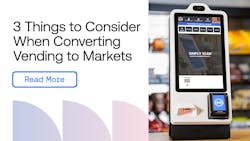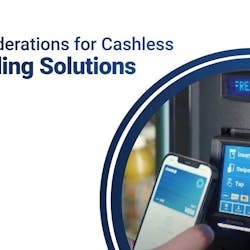The unattended retail market has been ruled by vending machines for years, but with the emergence of micro markets, a new era has begun thanks to technology and a changing workforce.
And for good reason. Micro markets can lead to increased sales and better customer satisfaction. However, transitioning from vending to micro markets doesn’t happen overnight. Here are three things to consider before converting your vending machines to micro markets.
Return on investment
Although micro markets bring in more revenue than vending machines, they typically require a larger initial investment. To compare apples to apples, let’s position a four-machine vending bank against a typical micro market. Let’s dive into the numbers:
Two drink vending machines and two snack vending machines can have an upfront cost of around $10,000. To set up a full-size micro market with a full-size kiosk, your upfront cost could be around $12,000.
For a vending setup, data shows that the average customer spends around $7 a month. With micro markets, an average customer spends around $20 a month.
Over a full month, revenues for the vending setup are $1,200. With our micro market setup, those revenues are $4,000.
From here, we can calculate our breakeven point. With the monthly profits vs. initial investment and operating costs, you can expect to break even with four vending machines in about 17 months. To break even with a micro market, it will take you about 7 and a half months.
Let’s take our profit figures and extend them over a year. Your expected annual gross profit from the vending machine setup is $4,800 per year. With a micro market, your annual gross profit will be around $19,200.
In this scenario, micro markets clearly have an increased upfront cost, but a much higher earnings potential.
Account factors
Vending machines are secure and locked, while micro markets operate on an open, honor-system setup. As a result, micro markets often don’t work in public locations. Instead, you’ll have to put them in secure environments with little in and out traffic, like manufacturing facilities or offices.
The size of your account is another factor to consider when placing a micro market. How many employees does the account have? Ideally, the best micro markets are in locations of 250+ people, but they can work in areas with as few as 75. Plus, you’ll need a larger space and an internet connection when placing a micro market. Make sure you have the perfect location before diving into markets or converting a vending setup to a micro market setup.
Logistics
When examining vending machines, routine service is relatively straightforward. You have a limited number of spirals, which means few products. Limited products make stocking a vending machine a quick process.
In contrast, micro markets often have hundreds of SKUs. More SKUs means more products in your warehouse, more time spent servicing the micro market, and other increased service costs.
Additionally, fresh food items such as salads, sandwiches and juices have high market demand, requiring a close eye on storage and expiration dates.
On the other hand, vending machines tend to have more technical issues, whether that be from spiral issues to full-on breakdowns. With micro markets, breakdowns are less frequent.
Before diving into micro markets, make sure your infrastructure is prepared to handle them. Consider factors like warehouse space, new product suppliers, service frequency and more.
Micro markets are undoubtedly more profitable than traditional vending machines. To remain competitive in the unattended retail industry, operators must be prepared to offer services as expected by high-value accounts. But before you get started, you need to consider the upfront investment, account type, and internal logistics to properly run a micro market business. Interested in learning more? Contact 365 Retail Markets today.





